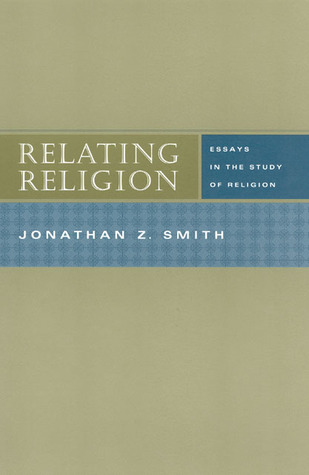"Relating Religion: Essays in the Study of Religion" by Jonathan Z. Smith.
"Jonathan Z. Smith is one of the two or three most widely read and discussed living theorists of religion. He has been publishing in that field for almost forty years." - Paul J. Griffiths [Source: Amazon].
Wikipedia:
Jonathan Zittell Smith (J. Z. Smith) is a historian of religions. His research includes the theory of ritual, Hellenistic religions, Māori cults in the 19th century, and the mass suicide in Jonestown, Guyana. His works include Map is Not Territory, Imagining Religion: From Babylon to Jonestown, To Take Place: Toward Theory in Ritual, Drudgery Divine: On the Comparison of Early Christianities and the Religions of Late Antiquity, and Relating Religion: Essays in the Study of Religion.Below is an excerpt from Bruce Lincoln's 2012 book, "Gods and Demons, Priests and Scholars: Critical Explorations in the History of Religions," University of Chicago Press: Chicago. Pg. 117.
Smith graduated from Haverford College in 1960 with a B.A. in philosophy, and took his Ph.D. in the history of religions from Yale University in 1969; with a thesis on anthropological thought, focused on Frazer, "The Glory, Jest and Riddle: James George Frazer and The Golden Bough." . . . Intellectually, Smith has been influenced by neo-Kantian thinkers, especially Ernst Cassirer and Émile Durkheim. He has also been influenced by Claude Lévi-Strauss.[5] Smith's dissertation focused on James Frazer's The Golden Bough and the method that Frazer used in the comparison of different religions. Since then much of Smith's work has focused on the problem of comparison and how best to compare data taken from societies that are very different from one another.
"Bruce Lincoln is the Caroline E. Haskell Professor of the History of Religions, Middle Eastern Studies, and Medieval Studies at the University of Chicago, where he is also an associate in the Departments of Anthropology and Classics." "Tackling many questions central to religious study, Gods and Demons, Priests and Scholars will be a touchstone for the history of religions in the twenty-first century." [Source: Amazon].
"In the Fall of 1971, I was fortunate to begin my graduate studies with a class offered by Jonathan Z. Smith as an introduction to the history of religions. At the time, Smith was locked in a personal and intellectual struggle with Mircea Eliade, then the dominant figure in the discipline. At that point, the nature of this struggle was not as clear as it would later become, nor did entering students realize how high were the stakes; but it was hard not to feel the tension and excitement of the moment.Video Title: Dr. J. Z. Smith. Source: YouTube Channel AmScholarsReligion. Date Published: November 21, 2012. Description:
Several episodes from that era remain indelible, but none more so than a day when Smith entered class late, visibly shaking with frustration and nervous energy. He had just left Eliade--whom I had not yet met---and they had been forced to break off an important conversation. "We were arguing about which came first," he explained, "order or disorder." Predictably, Eliade favored order and Smith the reverse, and their exchange produced only partial agreement. "He forced me to acknowledge," Smith went on, "that disorder can only exist in contrast to a prior order. I don't know if that's just a sly debater's point, but I have to take it seriously. So I'm prepared to concede that order came first, but only by one half-second! After that, I insist there was always disorder."
At the time, I was impressed by both men, by the intelligence---also the integrity---of the positions they articulated, and the importance of their disagreement. I wasn't sure who had gotten the better of the debate, but I could see that astute and principled arguments had been made on both sides. I knew enough to understand that Hesiod's notion of Chaos was a crucial datum for the discussion, and that other myths of the chaotic also figured implicitly, but most of the subtleties were quite lost on me. It was clear, however, that giants were throwing thunderbolts, and worlds could turn on the outcome.
Having now had forty years to reflect, I am inclined to think that both Eliade and Smith got things wrong, as becomes clear from the mythic narratives we have considered. Thus, all three cosmogonic accounts (those of Hesiod, Snorri, and the Pahlavi texts) begin by positing a primordial situation that includes---either alone or as part of a relatively small set---a vague, murky, unformed, decidedly insubstantial entity, rich in potential and neutral, even benign, in its disposition. This image represents neither "order," "disorder," nor anything of the sort: not yet, at any rate. Rather, it is simply "the chaotic," that is, the nebulous Etwas that meditates Nonbeing and Being as the precondition of all subsequent creation. The situation is precosmic and thus, a fortiori, premoral and prepolitical."
This video is part of a series of videos focused on the work of scholars of religious studies and theology in America. Learn and watch more by going to Fairfield University's Digital Commons atPart 1:
http://digitalcommons.fairfield.edu/asrvideos/
Part 2: (Dr. Jonathan Z. Smith Engages with the Question: Do You Think People Would Be Religious If They Were Never Going to Die?)
[Cannot find Part 3]. Part 4:
Part 5:
Part 6:
Part 7:
[Cannot find parts 8-10]. Part 11:
Part 12:
